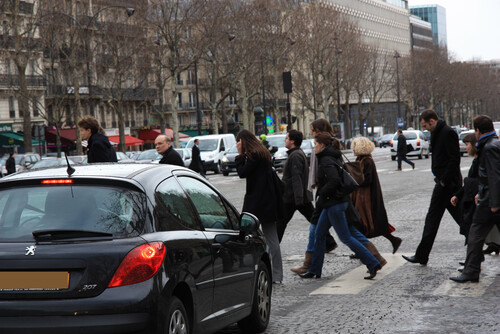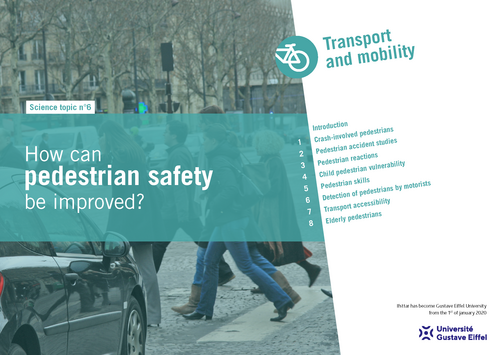How can pedestrian safety be improved?
Pierre-Jean Arnoux, Scientific coordinator of the science topic, Gustave Eiffel University
Although recent years have seen a considerable drop in the number of casualties on roads, in proportional terms pedestrians are still at particularly high risk, both in developed and emerging countries. The Gustave Eiffel University’s efforts to improve the safety of so-called “vulnerable users” involves several scientific disciplines and analysis at various scale levels.
Prior to the accident, analysing the behaviour of the user in the environment
This analysis suggests ways of improving the organisation of transport systems, both with regard to highway design and street furniture. Considerable study is devoted to elderly persons, whose perceptive, cognitive and motor capacities may be impaired. The use of simulators allows investigating the influence of these impairments and may have the potential to become a tool for relearning. This approach relates both to pedestrians, in order to improve their ability to move around within the urban space, and drivers for whom the attentional ability to detect pedestrians in time and perform an appropriate manoeuvre in time is essential.
A large number of issues
An analysis of the accident scenario is essential in order to develop active safety devices with the potential of avoiding the accident or warning the driver while at the same time allowing for the reactions of the pedestrian.
Studying the physical vulnerability of the pedestrian by gaining an understanding of the mechanisms responsible for injury is also a concern. This makes it possible to influence vehicle design by proposing appraisal standards. An approach combining experimental tests with numerical simulations permits broadly based, realistic investigations taking account of a large number of parameters that apply to the vehicle (shape, location of impact point, speed) and the pedestrian (size, position, posture). The value of developing both active and passive countermea-sures for cars is therefore obvious. The concept of integrated solutions, which combine active systems and passive safety, is one that opens up considerable opportunities for Gustave Eiffel University.
Post-accident analysis and clinical care of casualties
This stage is essential in order to provide input for our research topics. Statistical analysis of trauma (including the follow up of casualties and monitoring their rehabilitation) or alternatively the detailed analysis of accidents gives valuable data for identifying risk factors or the conditions under which the accident occurred. We have thus been able to show that risk exposure is higher for men than for women. The youngest individuals and the elderly are undeniably groups with a high risk, with different injury typologies. Gustave Eiffel University conducts wide-ranging research, in some cases in the framework of national and international collaboration, in order to understand the vulnerability of pedestrians and improve their safety. All in all, Gustave Eiffel University is able to deploy its research capabilities in a very large number of areas. The university can thus propose solutions for prevention and training, improving infrastructure and, lastly, the physical protection of this group of road users.
Read the full science topic in PDF format
Pedestrians remain particularly exposed in both developed and emerging countries.

Credits : S. Jeannin - Université Gustave Eiffel
Summary
Introduction
Identifying the characteristics of pedestrians involved in a crash
- By Jean-Louis Martin
Understanding accident processes
Observing pedestrian reactions when there is a risk of an imminent impact
Understanding pedestrian vulnerability and improving protection : the case of child pedestrians
- By Damien Montoya
What skills are needed to cross a road?
Improving the detection of vulnerable users by motorists
Identifying barriers to transport accessibility for pedestrians of reduced mobility
Understanding and improving the street crossing decisions for elderly pedestrians
Identity card of the science topic
| Title: | How can pedestrian safety be improved? |
| Coordinator: | Pierre-Jean Arnoux |
| Authors: | Jean-Louis Martin, Thierry Brenac, Thomas Robert, Damien Montoya, Marie-Axelle Granié, Joceline Rogé, Claude Marin-Lamellet, Aurélie Dommes |
| Collection: | Ifsttar sciences topics |
| Version: | PDF for free download in web and print versions |
| Licence: | Creative Common CC BY-SA 4.0 |
| Publication: | Published on January 2015, updated in september 2017 |
| Languages: | French and english |
| Keywords: | Pedestrians, risks, accidents, devices, mobility, safety, transportation, accessibility, Ifsttar science topics |

